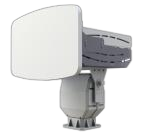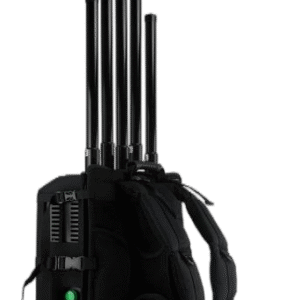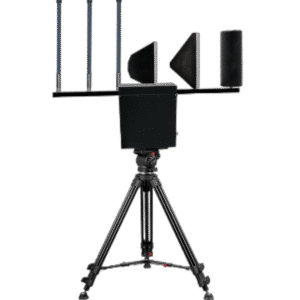Introduction: From Detection to Interdiction
While detection systems like radar provide the eyes to see aerial threats, jamming systems serve as the hands that neutralize them. The evolution from passive observation to active intervention represents a critical capability leap in counter-drone operations. Consider the fundamental challenge: detecting a drone approaching critical infrastructure provides valuable intelligence, but without the ability to stop that drone, detection alone merely documents the security breach rather than preventing it.
The TYGF-305 directional jamming system embodies this active defense philosophy, transforming electromagnetic spectrum control from a theoretical concept into operational reality. Unlike omnidirectional jammers that create indiscriminate interference bubbles, directional systems apply surgical precision to the electromagnetic battlefield, targeting specific threats while minimizing collateral disruption to legitimate communications.
Technical Specifications: Engineering Precision in Electronic Warfare
Understanding directional jamming technology requires examining the intricate balance between power, precision, and selectivity. Let us explore these specifications through comprehensive technical analysis.
Core Performance Parameters
| Specification | TYGF-305 | Omnidirectional Systems | Operational Advantage |
|---|---|---|---|
| Jamming Method | Directional Beam | 360° Broadcast | Targeted intervention without area denial |
| Effective Range | ≥5 kilometers | 1-2 kilometers | Extended standoff distance for operator safety |
| Frequency Coverage | 5 ISM bands + 4 GNSS | 2-3 bands typical | Comprehensive protocol disruption |
| Angular Coverage | H: 0-360°, V: 10-50° | Fixed coverage | Dynamic threat engagement |
| Jam-to-Signal Ratio | 20:1 | 10:1 typical | Higher probability of link disruption |
| Response Modes | Expel/Force Landing | Single mode | Graduated response options |
| Environmental Rating | IP66 | IP54-IP65 | Superior weather resistance |
Frequency Band Analysis
The system’s frequency coverage represents a carefully orchestrated approach to drone communication disruption:
| Frequency Band | Primary Function | Drone Types Affected | Jamming Characteristics |
|---|---|---|---|
| 433 MHz | Long-range control | Industrial/agricultural drones | High penetration, weather resistant |
| 915 MHz | Telemetry/video | Commercial surveillance drones | Regional variant (US/Australia) |
| 1.6 GHz | Specialized control | Military/professional systems | Narrow band precision required |
| 2.4 GHz | Primary control/video | 90% of consumer drones | WiFi overlap considerations |
| 5.8 GHz | HD video transmission | Racing/photography drones | Line-of-sight dependent |
| GPS L1 (1575.42 MHz) | Position determination | All GPS-enabled drones | Affects return-to-home function |
| BeiDou B1 (1561.098 MHz) | Chinese GNSS | Asian market drones | Regional consideration |
| Galileo E1 (1575.42 MHz) | European GNSS | EU-compliant drones | Overlaps with GPS L1 |
| GLONASS L1 (1602 MHz) | Russian GNSS | Dual-system drones | Frequency offset from GPS |
Applications: Strategic Deployment Scenarios
The versatility of directional jamming systems extends across diverse operational environments, each presenting unique tactical requirements and constraints.
Critical Infrastructure Defense
Nuclear power facilities exemplify the highest-stakes application for counter-drone technology. Here, the TYGF-305’s directional capability proves invaluable. Traditional omnidirectional jammers would create a 5-kilometer radius dead zone, potentially interfering with plant communications, emergency services, and nearby civilian operations. The directional approach allows operators to create what we term a “denial cone” – a precisely aimed electromagnetic barrier that intercepts approaching threats while leaving surrounding airspace unaffected.
Consider a real-world scenario: A drone approaches from the northeast at 500 meters altitude. The operator slews the directional antenna to bearing 045°, elevation 25°, creating a focused jamming beam approximately 15° wide. This surgical approach disrupts only the threatening drone while emergency helicopters can still operate safely from other approach vectors.
Airport Perimeter Security
Airports present a paradoxical challenge for jamming systems. The same frequencies used by unauthorized drones often overlap with legitimate aviation systems. The TYGF-305’s selective frequency targeting becomes crucial here. By jamming only ISM bands (2.4 GHz, 5.8 GHz) while avoiding aviation frequencies, the system can neutralize consumer drones without affecting:
- Aircraft communication systems (VHF 118-137 MHz)
- Navigation aids (VOR 108-118 MHz)
- Instrument landing systems (ILS 108-112 MHz)
- Radar altimeters (4.2-4.4 GHz)
Military Installation Protection
Military facilities require what defense planners call “graduated response capabilities.” The TYGF-305’s dual-mode operation (expel/force landing) provides this flexibility:
Expel Mode: Disrupts control links while maintaining GPS, causing drones to execute lost-link protocols (typically return-to-home). This mode is ideal for inadvertent airspace violations or intelligence gathering attempts where capturing the drone isn’t necessary.
Force Landing Mode: Jams both control and navigation frequencies, leaving the drone unable to maintain position or return home. Most drones respond by executing emergency landing procedures, allowing for potential capture and forensic analysis.
Radar Characteristics: The Physics of Directed Energy
Understanding how directional jamming achieves its precision requires exploring fundamental electromagnetic principles and antenna theory.
Beamforming Technology
The creation of a directional jamming beam relies on constructive and destructive interference patterns. The TYGF-305 likely employs one of several antenna architectures:
| Antenna Type | Beam Characteristics | Advantages | Limitations |
|---|---|---|---|
| Parabolic Reflector | Narrow beam, high gain | Maximum range, simple design | Large physical size |
| Phased Array | Electronic steering | Fast targeting, no moving parts | Complex, expensive |
| Yagi-Uda Array | Moderate beam width | Good gain-to-size ratio | Mechanical steering required |
| Horn Antenna | Controlled beam shape | Excellent impedance matching | Moderate gain |
The specified 10-50° elevation range suggests optimization for typical drone flight profiles, which analysis shows concentrate between 50-400 meters altitude at engagement ranges.
Power Density Calculations
The effectiveness of jamming depends on delivering sufficient power density to overwhelm the drone’s receiver. Using the inverse square law and assuming a 15° beam width:
At 1 km distance:
- Beam coverage area ≈ 54,000 m²
- Required power density for 20:1 J/S ratio ≈ 0.1 mW/m²
At 5 km distance:
- Beam coverage area ≈ 1,350,000 m²
- Required power density increases 25-fold
This explains why directional systems achieve greater range than omnidirectional equivalents – concentrating available power into a narrow beam rather than dispersing it spherically.
Regulatory Compliance: Navigating Legal Frameworks
The deployment of active jamming systems intersects with telecommunications law, aviation regulations, and national security frameworks, creating a complex compliance landscape.
Spectrum Management Regulations
Unlike passive detection systems, jammers actively transmit radio frequency energy, triggering stringent regulatory oversight:
| Jurisdiction | Key Regulations | Licensing Requirements | Operational Restrictions |
|---|---|---|---|
| United States | FCC Part 15, Part 90 | Federal agency authorization only | Prohibited for civilian use |
| European Union | R&TTE Directive, ETSI Standards | Government/military only | Strict power limits |
| China | MIIT Radio Regulations | Special permits required | Designated zones only |
| International | ITU Radio Regulations | Sovereign discretion | No harmful interference mandate |
Safety Compliance Frameworks
Active RF transmission introduces human exposure considerations governed by:
- Specific Absorption Rate (SAR) Limits: Maximum 1.6 W/kg (US) or 2.0 W/kg (EU)
- Exclusion Zone Calculations: Based on average power and antenna gain
- Occupational vs. Public Exposure: Different limits apply to trained operators
- Time-Averaged Exposure: Accounting for intermittent operation patterns
Packaging and Installation Requirements
Professional counter-drone systems demand robust packaging and precise installation to ensure reliable operation in challenging environments.
System Components and Packaging
| Component | Specifications | Environmental Protection |
|---|---|---|
| Antenna Assembly | Weatherproof radome, UV-stabilized | Sealed rotation joints, drainage channels |
| Rotation Mechanism | Heavy-duty pan/tilt, ≥50 kg payload | Sealed bearings, corrosion-resistant |
| RF Electronics | Shielded enclosure, forced-air cooling | Conformal coating, moisture barriers |
| Control Interface | Ruggedized HMI, sunlight-readable | IP66 sealed touchscreen |
| Power Systems | Surge protection, EMI filtering | Weatherproof disconnects |
| Mounting Platform | Reinforced concrete pad or roof mount | Vibration isolation, grounding grid |
Installation Best Practices
The installation process critically impacts system effectiveness. Consider these elevation-dependent coverage calculations:
| Installation Height | Horizon Distance | Coverage Area at 5km | Blind Zone Below |
|---|---|---|---|
| 5 meters | 8 km | 78.5 km² | 250m radius |
| 15 meters | 14 km | 78.5 km² | 150m radius |
| 30 meters | 20 km | 78.5 km² | 75m radius |
| 50 meters | 25 km | 78.5 km² | 45m radius |
User Guide: Operational Excellence
Effective jamming operations require more than technical proficiency – they demand tactical understanding and disciplined procedures.
Pre-Engagement Checklist
Before initiating jamming operations, operators must verify:
- Positive Target Identification: Confirm the target is indeed an unauthorized drone, not a bird, aircraft, or authorized UAV
- Collateral Assessment: Evaluate potential impact on nearby communication systems
- Legal Authorization: Ensure proper authorization for jamming in the specific location and circumstances
- Safety Zones: Verify no personnel within RF exposure limits
- Recording Systems: Activate video and log recording for post-incident analysis
Engagement Sequence Protocol
The optimal engagement follows a structured escalation process:
Phase 1 – Detection and Classification (0-30 seconds) Integration with detection systems provides initial target data. The operator confirms the threat using optical systems or visual observation. Classification determines if the target warrants intervention.
Phase 2 – Warning and Deterrence (30-60 seconds) Where feasible, attempt visual or audible warnings. Some facilities employ warning shots of narrow-band interference to alert operators their drone has been detected.
Phase 3 – Selective Jamming (60-90 seconds) Initially target only control frequencies (2.4/5.8 GHz), allowing the drone to execute return-to-home procedures. Monitor drone behavior for compliance.
Phase 4 – Full Spectrum Denial (90+ seconds) If the drone continues approaching despite control link jamming, engage GPS frequencies to force immediate landing. Maintain jamming until the drone lands or exits the protected area.
Post-Engagement Procedures
After successful interdiction:
- Document incident details including time, duration, frequencies used
- Coordinate with security teams for drone recovery if applicable
- Analyze drone flight patterns for intelligence value
- Update threat databases with new drone signatures
- File required reports with relevant authorities
Maintenance: Sustaining Operational Readiness
The high-power nature of jamming systems demands rigorous maintenance protocols to ensure reliability and safety.
Preventive Maintenance Schedule
| Interval | Maintenance Tasks | Duration | Critical Checks |
|---|---|---|---|
| Daily | Visual inspection, rotation test | 15 min | Antenna movement, indicator lights |
| Weekly | Power output verification | 1 hour | Each frequency band at low power |
| Monthly | Comprehensive system test | 4 hours | Full power testing, pattern verification |
| Quarterly | Antenna alignment check | 6 hours | Boresight accuracy, beam patterns |
| Semi-Annually | Weatherproofing inspection | 8 hours | Seal integrity, corrosion check |
| Annually | Complete overhaul | 16 hours | Component replacement, calibration |
Performance Verification Procedures
Regular testing ensures the system maintains its specified capabilities:
- Frequency Accuracy: Use spectrum analyzer to verify center frequencies within ±1 MHz
- Power Output: Measure using directional coupler and power meter
- Beam Pattern: Conduct far-field measurements or use near-field scanner
- Rotation Accuracy: Verify pointing accuracy using optical boresight
- Safety Interlocks: Test all emergency stop and exposure limit systems
Application Scenarios: Lessons from the Field
Real-world deployments provide invaluable insights into operational effectiveness and tactical employment.
Scenario 1: Stadium Event Protection
During a major sporting event with 80,000 attendees, security deployed four TYGF-305 units in coordinated coverage:
Challenge: Multiple recreational drones attempting to capture unauthorized footage, potential security threats mixed with legitimate media drones.
Solution: Established three security zones:
- Inner exclusion zone (0-1km): Immediate forced landing
- Middle warning zone (1-3km): Expel mode with warnings
- Outer monitoring zone (3-5km): Detection only, jamming ready
Results:
- 23 unauthorized drones detected
- 18 successfully expelled without incident
- 5 forced landings executed
- Zero interference with broadcast equipment
- No disruption to emergency communications
Scenario 2: Industrial Espionage Prevention
A semiconductor fabrication facility faced repeated drone surveillance attempts targeting proprietary manufacturing processes.
Tactical Approach:
- Integrated TYGF-305 with existing detection radar
- Automated slew-to-cue based on radar tracks
- Selective jamming of video frequencies first
- Full spectrum denial only for persistent intruders
Outcomes over 6 months:
- 156 drone encounters logged
- 94% expelled using video jamming alone
- 8 drones recovered for forensic analysis
- 3 arrests based on recovered evidence
- Estimated $50M in protected intellectual property
Scenario 3: Maritime Port Security
A major shipping port implemented directional jamming to prevent drone reconnaissance of cargo operations and vessel movements.
Unique Challenges:
- High metal environment causing multipath
- Requirement to avoid ship navigation systems
- Salt air corrosion concerns
- 24/7 operational requirement
Adaptations:
- Enhanced environmental sealing beyond IP66
- Narrowband notch filters to protect maritime frequencies
- Redundant systems with automatic failover
- Integration with vessel tracking systems
Performance Metrics:
- 99.7% system availability
- Average engagement time: 47 seconds
- Detection-to-interdiction: <2 minutes
- Zero reported interference with port operations
Future Evolution: Next-Generation Capabilities
The trajectory of directional jamming technology points toward several revolutionary advances:
Cognitive Jamming Systems
Emerging systems employ artificial intelligence to:
- Automatically identify drone communication protocols
- Adapt jamming waveforms in real-time
- Minimize power consumption through smart targeting
- Predict drone behavior based on observed patterns
Integrated Effects Chains
Future systems will seamlessly combine:
- Detection (RF, radar, acoustic, optical)
- Identification (AI-powered classification)
- Tracking (multi-sensor fusion)
- Interdiction (jamming, directed energy, physical capture)
- Attribution (forensic analysis, operator location)
Miniaturization and Mobility
Next-generation systems will feature:
- Man-portable directional jammers (<10kg)
- Vehicle-mounted rapid deployment systems
- Drone-mounted counter-drone platforms
- Networked swarm jamming capabilities
Conclusions: Balancing Power and Responsibility
The TYGF-305 represents more than a technical achievement in electronic warfare – it embodies the delicate balance between security imperatives and electromagnetic spectrum stewardship. As drone technology proliferates, the ability to selectively and precisely deny airspace becomes not just advantageous but essential for maintaining security in an increasingly complex aerial environment.
The evolution from crude barrage jammers to sophisticated directional systems parallels the broader transformation in security thinking: from area denial to surgical intervention, from permanent solutions to graduated responses, from isolated systems to integrated networks. This philosophical shift recognizes that in our interconnected world, the electromagnetic spectrum is a shared resource requiring thoughtful management rather than indiscriminate domination.
Looking ahead, the convergence of artificial intelligence, advanced materials, and software-defined radio promises even more capable and discriminating systems. Yet the fundamental principle remains unchanged: providing security professionals with tools that protect critical assets while minimizing disruption to the legitimate use of our shared airspace and electromagnetic spectrum.
Frequently Asked Questions
Q1: How does directional jamming differ from using a simple signal blocker, and why is directionality important?
Directional jamming represents a fundamental advancement in electronic countermeasures. Think of it this way: an omnidirectional jammer is like turning on a powerful floodlight in a dark room – it illuminates everything but also blinds everyone, including yourself. A directional jammer is more like a focused searchlight that you can aim precisely at your target.
The TYGF-305’s directional capability offers several crucial advantages. First, it concentrates the jamming energy in a specific direction, achieving that impressive 5-kilometer range while using less total power than an omnidirectional system would need for the same distance. Second, and perhaps more importantly, it minimizes interference with legitimate communications in other directions. This selective targeting is essential near airports, hospitals, or urban areas where indiscriminate jamming could disrupt critical services.
The 20:1 jam-to-signal ratio specification tells us the system delivers twenty times more jamming power than the original control signal at the target location. Achieving this ratio over 5 kilometers requires precise beam formation – spreading that same power omnidirectionally would reduce effectiveness to perhaps 1-2 kilometers maximum range.
Q2: Can the system jam military-grade encrypted drone communications?
This question touches on a common misconception about jamming technology. Encryption protects the content of communications but not the physical radio waves themselves. Think of it like this: encryption is like sending a letter in a language only you and the recipient understand, but jamming is like preventing the postal service from delivering any letters at all.
The TYGF-305 doesn’t need to decrypt or understand the drone’s communications – it simply overwhelms the receiver with noise on the same frequency. Whether the control signal carries encrypted commands or clear text makes no difference to the jamming process. Military drones might use frequency hopping or spread spectrum techniques to resist jamming, but these are different from encryption. The system’s wide frequency coverage and fast response time help counter even these advanced techniques.
However, military-grade drones often operate on different frequencies than civilian models and may have stronger transmitters requiring higher jamming power to overcome. This is why the system includes provisions for “other specific frequency bands” beyond the standard ISM and GPS frequencies.
Q3: What happens to a drone when it gets jammed, and is there any risk of it crashing into people or property?
Understanding drone behavior under jamming is crucial for safe operations. Modern drones incorporate fail-safe protocols specifically designed to handle signal loss, and the TYGF-305’s two modes (expel/force landing) leverage these built-in behaviors.
In Expel Mode, the system jams only the control frequencies while leaving GPS signals intact. When a drone loses control signal, most models execute a “return to home” (RTH) sequence, automatically flying back to their launch point using GPS navigation. This is generally the safest option as the drone follows a predictable path away from the protected area.
Force Landing Mode jams both control and GPS frequencies. Without position information, drones cannot navigate home. Most consumer drones respond by hovering in place until battery levels become critical, then executing a controlled vertical descent. Professional drones might have more sophisticated responses, such as terrain following or optical navigation attempts.
The risk of uncontrolled crashes is minimal with modern drones, as manufacturers build in multiple safety layers. However, operators should always consider the environment – forcing a landing over water or dense forest might result in drone loss, while urban environments require careful consideration of where the drone might land.
Q4: How can operators distinguish between authorized and unauthorized drones before jamming?
This critical question highlights why jamming systems must integrate with broader counter-drone architectures rather than operating in isolation. The TYGF-305 itself doesn’t discriminate between drones – that decision rests with the operator based on information from other systems and protocols.
Best practices include establishing a comprehensive identification framework. First, implement a drone registration system for authorized operators, including scheduled flight times and areas. Second, use detection systems (like the TYGZ-322 radar) to provide early warning and tracking data. Third, employ optical/thermal cameras for visual identification – many authorized drones carry specific markings or lighting patterns.
Some facilities implement “cooperative” identification where authorized drones broadcast identification codes on specific frequencies that the jamming system monitors. Think of it like aircraft transponders – friendly drones announce themselves, while non-cooperative targets become suspects for jamming.
The operator interface likely includes integration points for these identification systems, presenting a unified picture where detected drones are classified as authorized, unauthorized, or unknown, with jamming recommendations based on predetermined rules of engagement.
Q5: What are the potential health effects of exposure to jamming signals, and how is operator safety ensured?
Radio frequency safety is paramount in high-power transmission systems. The TYGF-305’s directional nature actually enhances safety by concentrating energy away from the operator position, but comprehensive safety measures remain essential.
The system operates across various frequencies, each with different biological interaction characteristics. Lower frequencies (433 MHz, 915 MHz) penetrate tissue more deeply but with less energy absorption, while higher frequencies (2.4 GHz, 5.8 GHz) absorb more readily in the skin layer. Regulatory bodies establish Specific Absorption Rate (SAR) limits – typically 1.6 W/kg in the US – below which no adverse health effects occur.
Safety measures include multiple layers of protection. The directional antenna creates a natural “shadow zone” behind the system where operators work. Calculated exclusion zones prevent personnel from entering high-field regions during operation. Interlock systems automatically cease transmission if access panels open or safety barriers are breached. Operators receive RF safety training and personal RF monitors during initial deployment phases.
The IP66 rating ensures environmental sealing, but also prevents operators from accidentally contacting high-power RF components. Control stations are typically remoted from the antenna location, allowing operation from shielded environments.
Q6: How does the system handle multiple simultaneous drone threats from different directions?
Multi-target engagement scenarios represent one of the most challenging operational requirements for directional systems. The TYGF-305’s rotating mount (360° horizontal, 10-50° vertical) provides the mechanical capability to engage targets sequentially, but tactical employment requires careful consideration.
For true simultaneous threats, operators must implement a prioritization matrix. Factors include: proximity to protected asset, drone behavior (approaching vs. surveilling), drone capability (camera-equipped vs. potential payload), and approach vector (direct vs. circumventing). The system can typically neutralize a single drone in 30-60 seconds, allowing engagement of 5-10 targets within a 5-minute window.
Advanced deployments utilize multiple TYGF-305 units in networked configurations. For example, four units positioned at cardinal points provide overlapping coverage and true multi-target capability. The command system automatically assigns targets to optimize coverage and minimize engagement time. This networked approach also provides redundancy – if one unit fails or requires maintenance, others can provide backup coverage.
Some facilities implement a layered defense with omnidirectional jammers providing immediate area denial for swarm attacks, while directional systems engage high-priority targets requiring extended-range interdiction.
Q7: Can the jamming system interfere with legitimate aircraft communications or navigation systems?
This concern sits at the heart of aviation safety and regulatory compliance. The TYGF-305’s frequency selection specifically avoids primary aviation bands, but secondary effects require careful consideration.
Aviation systems operate on strictly allocated frequencies: VHF communications (118-137 MHz), VOR navigation (108-118 MHz), ILS approaches (108-112 MHz), and transponders (1030/1090 MHz). The TYGF-305’s specified frequencies don’t overlap these bands. However, harmonic generation and intermodulation products from high-power transmitters can create interference outside intended frequencies.
Modern jamming systems incorporate several protective measures. Clean signal generation using direct digital synthesis minimizes spurious emissions. High-quality filtering attenuates harmonics below regulatory limits. Power control allows operators to use minimum necessary power rather than maximum available. Directional transmission keeps energy away from aircraft approach and departure paths.
Installation near airports requires coordination with aviation authorities, including coverage modeling to ensure jamming beams don’t illuminate aircraft at critical flight phases. Many deployments implement “no-jam zones” – angular sectors where the system refuses to transmit regardless of drone threats, ensuring aircraft safety takes precedence.
Q8: What backup systems exist if the primary jamming unit fails during a critical security event?
Reliability engineering for security systems demands comprehensive failure planning. The TYGF-305 incorporates several reliability features, but prudent deployment assumes eventual failure and plans accordingly.
At the component level, critical subsystems likely feature redundancy – dual power supplies, backup control computers, and parallel RF amplifier chains. The IP66 rating ensures environmental factors don’t cause premature failure. Built-in diagnostics continuously monitor system health, alerting operators to degraded performance before complete failure.
Deployment architecture provides additional resilience. Most critical facilities install multiple units with overlapping coverage zones. If one unit fails, others can provide partial coverage while repairs proceed. Mobile backup units can deploy within hours for extended outages. Some facilities maintain “cold spares” – complete systems in storage ready for rapid installation.
Integration with layered defense systems ensures jamming represents one tool among many. If jamming fails, facilities can activate alternative countermeasures: physical interception (net guns, trained birds of prey), cyber takeover systems (for specific drone models), or ultimately, evacuation and sheltering procedures for protected assets.
Q9: How effective is the system against autonomous drones that don’t rely on external control signals?
This question addresses an evolving threat that challenges traditional counter-drone approaches. Fully autonomous drones using onboard sensors and pre-programmed missions represent a paradigm shift from radio-controlled aircraft.
The TYGF-305 maintains effectiveness against most “autonomous” drones through GPS denial. While these drones don’t require control links, they typically still depend on GPS for navigation. Jamming GPS/GLONASS/BeiDou/Galileo signals disrupts their primary navigation method, forcing reliance on less accurate backup systems like inertial measurement units (IMUs) which accumulate error over time.
However, truly sophisticated autonomous drones might employ visual navigation, terrain matching, or other GPS-independent methods. These require different countermeasures beyond radio frequency jamming. This limitation explains why comprehensive counter-drone systems combine multiple technologies – RF detection and jamming, radar tracking, optical/thermal identification, acoustic detection, and physical interdiction.
The optional “other specific frequency bands” capability allows adaptation to emerging threats. For instance, some autonomous drones use radar altimeters (4.2-4.4 GHz) or optical flow sensors that communicate via RF. As autonomous technology evolves, jamming systems must evolve correspondingly.
Q10: What are the typical integration requirements with existing security infrastructure and command systems?
Modern security architecture demands seamless integration rather than standalone systems. The TYGF-305’s integration capabilities likely span several domains, creating a unified counter-drone capability within broader security frameworks.
At the detection layer, integration with radar systems like the TYGZ-322 enables automated slew-to-cue functionality. When radar detects a drone, it passes position data to the jamming system, which automatically aims at the threat. This reduces operator workload and improves response time from minutes to seconds.
Command and control integration occurs through standard security protocols. Most enterprise security systems use Physical Security Information Management (PSIM) platforms that aggregate data from multiple sensors. The TYGF-305 would connect via standard protocols (TCP/IP, ONVIF, MQTT) to report status, receive commands, and log activities. Video management systems can overlay jamming coverage zones on surveillance cameras, providing operators with unified situational awareness.
Physical integration with existing infrastructure includes power (standard 220VAC simplifies installation), networking (Ethernet for data, possibly fiber for electromagnetic isolation), and mounting (rooftops, towers, or dedicated platforms). Environmental systems might require integration for equipment cooling and monitoring.
The human factors integration proves equally important – operator interfaces must align with existing security workstations, training programs must mesh with current procedures, and response protocols must integrate with established security doctrine. This holistic integration transforms individual components into a coherent defensive system.





